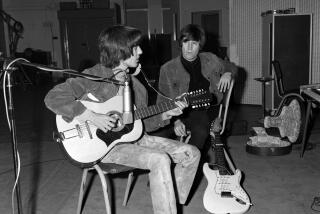A magical tour of Liverpool
Our family, exhausted after a day of sightseeing, must have seemed out of place in the busy, boisterous restaurant. “What brings you to Liverpool?” a young waitress asked.
“The Beatles,” I said with a smile.
“Oh,” she said, laughing, “Big Beatles fans, are you?”
“We’re on a pilgrimage,” said my daughter Lauren, 14, whose wit seemed right at home in Liverpool. “This is our Graceland.”
Just as Elvis fans flock to the King’s Memphis mansion, Beatles devotees make the journey to Liverpool, an industrial port city on the northwest coast of England — birthplace of John Lennon, Paul McCartney, George Harrison and Ringo Starr.
When fans first descended on the city in the ‘60s — at a time when band members and their families still lived here — they were regarded as a nuisance. But today they’re welcomed, possibly because the generation of teenagers who first embraced the Beatles are now the city’s and nation’s leaders.
There is much for an avid fan to see: In 1990, a museum dedicated to the group opened; in 1994, the site of a downtown nightclub, the Cavern Club, where the Beatles often played, was excavated and redeveloped; in 1995, the McCartney home began allowing tours; and last year, Lennon’s childhood home opened its doors.
Last summer, on a family vacation in England, my wife, Jane, and I rented a car in London and drove four hours north, with our daughters Lauren and Katherine, 11, and my 73-year-old mother, Gladys. Jane and I had visited the city 15 years earlier, but this was the first visit for the others.
The Beatles are special to all three generations. After their appearance on “The Ed Sullivan Show” in 1964, my father forbade us to play their records or even use the word “Beatles” in our home. Of course, that was all it took to make me, my then-preteen sisters and even my mother lifelong, loyal fans.
Main attractions
After our arrival in Liverpool, it didn’t take us long to find the two focal points for Beatles fans: Albert Dock, home of the Beatles Story Museum, and Mathew Street, location of the Cavern Club. Both are within easy walking distance of the Lime Street rail station and numerous hotels and restaurants.We began at Albert Dock, a 19th century cargo handling center, which now houses two hotels, luxury apartments, restaurants and three museums.
The Beatles Story Museum gives the group’s history, with a part of the museum dedicated to the Beatles’ musical influences — especially American rock ‘n’ roll.
Thorough exhibits document the spread of Beatlemania throughout England and the U.S. and the growth of the band through the ‘60s. Beatles music from each period plays throughout the museum, and special exhibits focus on the solo careers of each band member.
A favorite exhibit was the white room. It’s a moving and somber tribute to Lennon that features a white grand piano in a room decorated in various shades of white, matching the interior of the New York apartment where Lennon composed the song “Imagine.” That recording plays continuously in the exhibit.
After visiting the museum, we bought a “ticket to ride” on Liverpool’s “Magical Mystery Tour” and climbed aboard a bright yellow tour bus with about 30 other passengers. As we rumbled around the city’s streets, our tour guide, Edwina Swaden, a lifelong Liverpool resident and a Beatles fan “from the beginning,” entertained us with jokes and puns referring to Beatles titles and lyrics.
Our first stop, shortly after leaving the docks, was the Dingle — the inner-city neighborhood where Ringo (Richard Starkey) was born and raised. We took a short walk to see his former home and take pictures.
We moved on to Penny Lane, in a quiet suburban neighborhood — a disappointing stop. There was little to see beyond a couple of Penny Lane street signs. The fun is at the northern end of the street, where there is a pleasant neighborhood with small cafes, shops and businesses, and several landmarks mentioned in the song “Penny Lane.” The bus breezed through quickly, and we decided we’d come back on our own.
We stopped for another photo op at Strawberry Field, a children’s home with expansive grounds owned by the Salvation Army. The bus pulled over next to an unused gate, but all we could do was peek in, because the home is closed to the public.
Along the way the tour passed many sites important in the lives of the Beatles. At each, tour guide Swaden had an interesting anecdote, often with an ironic or amusing twist. When we passed the Anglican Cathedral on Hope Street, she told us young McCartney didn’t pass an audition for the choir. But decades later he premiered his “Liverpool Oratoria” there.
The tour stopped at the homes of Paul, John and George for more photo opportunities — and a quick look around that gave us a sense of the band members’ roots. George and Paul lived in working-class neighborhoods, whereas John’s home was decidedly middle class. We also saw Beatles’ manager Brian Epstein’s elegant home in a posh part of town.
Landmark club
The Magical Mystery Tour ends at Mathew Street, where the Beatles played nearly 300 times at the old Cavern Club from 1961 to 1963. The club, in a basement, was demolished in the ‘70s to make room for a subway that was never built. A new Cavern Club opened here in 1984 and offers live entertainment daily. There are numerous Beatles-oriented shops and tributes on Mathew Street. Across from the entrance to the Cavern Club is a life-size statue of Lennon standing in front of a Wall of Fame, engraved with the names of acts that played at the club from 1957 to 1973.We also visited Merseyside Maritime Museum, where we saw the original gold records for the single “A Hard Day’s Night” and the album “Something New.”
We returned to Albert Dock after lunch to join a tour group headed for 20 Forthlin Road and Mendips, the McCartney and Lennon homes, respectively. Both are owned by National Trust, a registered charity that manages more than 300 of England’s most important historical and cultural buildings and archeological sites.
The McCartney home, in a quiet neighborhood, is a plain brick row house with a tiny yard in front and a small garden in the rear. The McCartneys moved here in 1955 when Paul was 12. Paul’s mother, Mary McCartney, died of breast cancer in October 1956. Paul’s father, Jim, lived at this home until 1964. He died in 1976.
John Halliday, curator of the home and its only resident, welcomed our small group, providing each of us with headphones and audio playback devices. On them, Paul and his brother Michael describe McCartney family life. Using Michael’s photos from the period as a guide, the National Trust restored the home to its early ‘60s appearance.
After touring the first floor, I noticed that most visitors were solemnly tiptoeing up the stairs to the second floor. When it was our turn, I waited until my daughters reached the top of the narrow staircase, then bounded up the steps. The kids glared at me. I explained that I imagined that teenager McCartney always ran up the stairs that way.
I poked around, taking in a collection of Beatles memorabilia that was on display. Michael’s photos from the early ‘60s adorned the walls. There’s no chance enterprising visitors will make copies of them, because cameras aren’t allowed. It helps protect Michael’s copyright.
Cellphones aren’t allowed either. Halliday said when the home opened for tours, guests often could be heard shouting from the upstairs bedrooms. The cause? They were using their cellphones to call friends to brag they were in McCartney’s bedroom. So the use of cellphones is strictly, though politely, forbidden.
It’s a short drive from 20 Forthlin Road to Mendips, the childhood home of Lennon at 251 Menlove Ave. The home was built in 1933, a time when it was customary to give homes names rather than numbers for addresses, particularly in upscale neighborhoods. Mendips, named after a resort town in the southern English county of Somerset, still has the servant signaling system of lights and buzzers from that era.
Aunt Mimi’s house
In 1945, Lennon’s mother, Julia, was having trouble coping as the single parent of an energetic 5-year-old. So the boy was taken in by Julia’s older sister, Mimi Stanley, who raised him here with help from her husband, George. Julia was struck by a car and died shortly after visiting Mimi in 1958.Lennon and his first wife, Cynthia, stayed with Mimi for a short time after their son Julian Lennon was born, then moved to London in 1963.
Mimi stayed on until 1965, when John bought her a home in Poole, a resort town in southern England, where she lived until her death in 1992. Yoko Ono purchased the home in 2002 and donated it to the National Trust.
Though small by American standards, Mendips is larger and more comfortable than the McCartney home. It’s semi-detached, sharing a wall with the neighbor. It has a large garden with several mature fruit trees.
Our tour entered the home through the kitchen in the rear, which would have been the entry point for family members too, according to curator Mathew Whitfield.
The home has been restored to match its appearance when Lennon lived here, Whitfield said.
Mendips does not have an audio program; visitors are encouraged to bring their own interpretation. We strolled through the three-bedroom home, looking at some of Lennon’s favorite books and some of his early sketches. My wife was particularly impressed with the bright and cheerful room that once belonged to Mimi.
“They said this was John’s favorite place in the house,” Jane said. “I can see why. It’s such a pleasant room.”
As our tour was wrapping up, Lauren and Katherine stepped away from the group and enthusiastically bounded up the steps to the second floor, filling the home with laughter and giggles.
It was enough to make Dad proud.
*
(BEGIN TEXT OF INFOBOX)
Day tripper’s guide to Liverpool
GETTING THERE:
From LAX, US Airways, Delta, American, Continental, Swiss, British Airways and KLM offer connecting flights to Manchester, England. Restricted round-trip fares begin at $408. Liverpool is 27 miles from Manchester.
By train from London, Virgin Trains, P.O. Box 715, Birmingham, B5 4HHH; 011-44-870-789-1234, https://www.virgintrains.co.uk , offers daily connecting service (change of trains) from London’s Waterloo station to Liverpool’s Lime Street station, walking distance from Albert Dock, Mathew Street and downtown Liverpool. Round-trip fares start at $97.
Driving from London, rental cars are available in London; take the M1 Motorway to the M6, north, follow the M6 to the M62 to Liverpool, follow the signs to Albert Dock, avoiding all tunnels.
TELEPHONES:
To call the numbers below from the U.S., dial 011 (the international dialing code), 44 (country code), 151 (local code) and the number.
WHERE TO STAY:
Britannia Adelphi Hotel, Ranelagh Place, Liverpool, L3 5UL; 709-7200, fax 708-8326, https://www.britanniahotels.com . This high-rise has an excellent central location; easy walking distance to Mathew Street and Albert Dock. Doubles from $109.
Express by Holiday Inn, Britannia Pavillion, Albert Dock, Liverpool, L3 4AD; 709-1133, https://www.hiexpress.com . Another good location for Beatles fans. The hotel is part of the renovated Albert Dock complex. Doubles from $122.
Campanile Hotel, Wapping and Chaloner streets, Liverpool, L3 4AJ; 709-8104, It’s a five-minute walk from this low-rise hotel to Albert Dock. Doubles from $85.
WHERE TO EAT:
Ego, Hope Street; 706-0707, https://www.egorestaurants.com Mediterranean cuisine. Entrées start at $14.50.
Est Est Est, Edward Pavilion, Albert Dock; 709-8787, https://www.estestest.co.uk . This stylish, modern restaurant features Italian specialties. Entrées start at $12.75.
Lucy in the Sky With Diamonds, Cavern Walks, Mathew Street; 236-0096. Beatles-themed café offers a modest selection of sandwiches and desserts. Entrées start at $9.
BEATLES TOURS:
Magical Mystery Tour/Cavern City Tours, 8 Mathew St.; 236-9091 https://www.cavern-liverpool.co.uk . Two-hour bus tours start at $20 per person.
Live@pool Tours, 21-23 Slater St., Liverpool L1 4BW; 330-0844, https://www.liveapool.com . Private taxi tours of Beatles-themed events and sites, starting at $182 for groups of four.
20 Forthlin Road, Mendips, National Trust tours to the homes of Paul McCartney and John Lennon depart from Albert Dock and from Speke Hall, Speke Hall Avenue; 427-7231, https://www.nationaltrust.org.uk . Tours are not held daily; check website for schedule.
The Beatles Story Museum, Britannia Pavilion, Albert Dock; 709-1963, https://www.beatlesstory.com . Open daily except Christmas. Admission: $15 adults, $9 children.
EVENTS:
International Beatle Week, Aug. 26-31, features conventions and concerts. Call 236-9091, https://www.cavern-liverpool.co.uk/beatleweek .
Mathew Street Festival, Aug. 28-30, is a free music event that coincides with International Beatle Week. Beatles tribute bands from around the world perform. Call 236-9091, https://www.mathewstreetfestival.co.uk .
— Ed Stockly
More to Read
Sign up for The Wild
We’ll help you find the best places to hike, bike and run, as well as the perfect silent spots for meditation and yoga.
You may occasionally receive promotional content from the Los Angeles Times.






